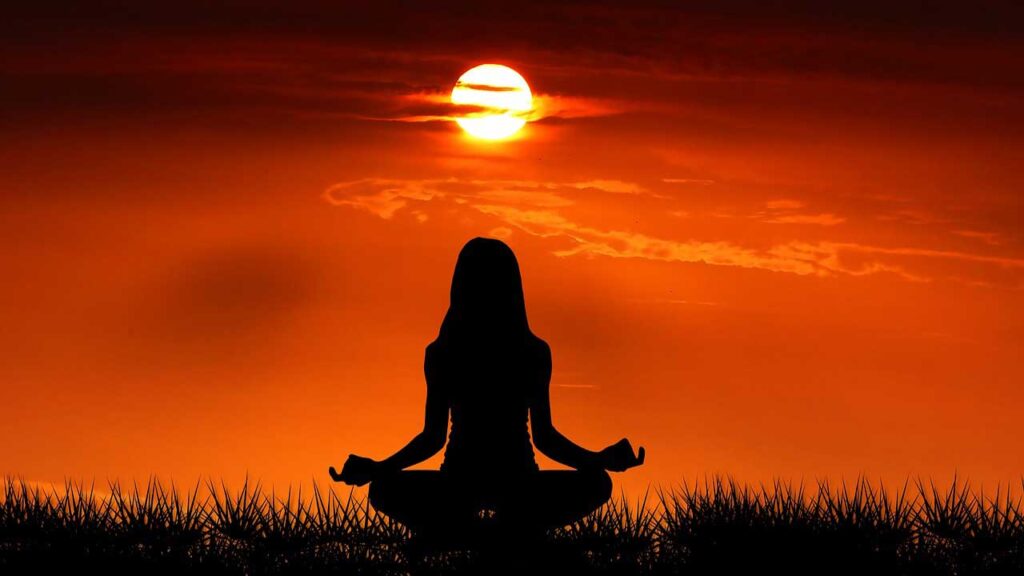
What is meditation and how to do it?
Podcast Link: To listen to related Podcast click here!
Video Link: To watch the related video click here!
_What is meditation?
_Meditation and Brain frequencies
_What are the four major brain frequencies?
_What happens when you meditate?
_Different kind of meditation form
_What are the benefits of meditation?
_Passive Meditation vs Active Meditation
_Edgar Cayce on meditation
_How to meditate? (The Edgar Cayce way)
_Conclusion
What is meditation?
The best practice to balance your mind, body and spirit is meditation and is one of the best to keep you healthy, calm you down, relax your body and mind.
Many people think that meditation is just sitting quiet some place and many others sleep during the meditation which is okay to fall in sleep but that’s not meditation, meditation is not only a relaxed state but very active in other situations, better say in metaphysical state.
Meditation is the practice of quieting your physical body and your mind, focusing your attention inward instead of upon the world around you.
Meditation is like listening to God or creator and on the other hand prayer is like talking to God.
Meditation and Brain frequencies
Meditation has direct relation with the brain frequencies, as you know we have four major brain frequencies and everyday we go through these frequencies as a cycle.
When messages are transmitted between neurons in the brain, this creates a current. Scientists call these currents brain waves “neural oscillations”.
What are the four major brain frequencies?
Here are the frequencies of brain from low to high hertz:
Delta waves:
Delta waves are high amplitude neural oscillations with a frequency between 0.5 and 4 hertz cycles per second which is deep dreamless sleep, loss of bodily awareness. Inhibiting delta waves results in a lack of bodily rejuvenation, diminished brain revitalization, and impaired sleep quality.
Theta waves:
waves generate frequencies between 4 and 8 hertz cycles per second which is the mind is in creativity, insight, deep states, dreams, deep meditation and reduced consciousness.
Alpha waves:
Alpha waves, or the alpha rhythm, are neural oscillations in the frequency range of 8–13 hertz cycles per second which is physically and mentally relaxed state or meditation state.
Beta waves:
Beta waves or beta rhythm, are a neural oscillation (brainwave) in the brain with a frequency range of between 13 and 32 Hz cycles per second. Beta states are the states associated with normal waking consciousness. Beta waves representing awake, alert consciousness, thinking and excitement state, planning, organizing.
Gamma waves:
waves are frequencies between 32 and 100 hertz cycles per second that represent heightened perception, learning problem solving tasks and cognitive processing, actively learning or in hyperactivity mode.
Monks and other accomplished meditators generate elevated levels of gamma brain waves, offering a range of advantages to cognitive performance.
All these brain waves correspond with a certain kind of activity.
What happens when you meditate?
When you meditate every cell in your body relaxes and you receive energy from Mother Earth because you synchronize with the vibration of the Earth.
Natural frequency of the Earth pulsates at a rate of 7.83 hertz cycle per second. It surrounds and protects all living things on the planet and it is the same rate as theta wave frequency known as deep meditation.
When you start to meditate your brain frequency moves from Beta level (13-32 hz) to Alpha level also meditate state (8-13 hz) and when you meditate regularly then your brain frequency even goes further to Theta level (4-8 hz) which is deep meditation state and you get all the benefits that come with every level of frequency.
During meditation you also notice the sense of peace inside you will stay with you all day long.
Meditation promotes coordination at three levels as follows:
_Physically, you begin to relax
_Mentally, your chatting thoughts become quiet and focused
_Spiritually, you get reenergized and will be able to deal more lovingly and effectively with the people and events around you.
Meditation develops many areas in the brain, in some part enhances the memory, compassion and empathy and in other parts decreases anxiety, fear and stress.
Different kind of meditation form:
Walking in the nature
Star gazing
Tantra meditation
Mindfulness meditation
Spiritual meditation
Focused meditation
Movement meditation
Mantra meditation
Transcendental meditation
Progressive relaxation
Loving-kindness meditation
Visualization meditation
Chakra meditation
And many more but every form of meditation is made for different purposes.
What are the benefits of meditation?
Meditation exerts a favorable impact on both health and well-being.
Strengthen the immune system
Increases happiness
Increases relaxation
Increases pain tolerance
Increases positive mood and feelings
Makes you calm
Puts you at peace
Physical and emotional well-being
Reduces depression
Reduces anxiety
Reduces mind wandering
Reduces stress
Enhances self-awareness
Enhances memory
Helps fight addictions
Generates kindness
Improves concentration
Improves sleep
Slows aging
And many more ….
Passive Meditation vs Active Meditation
When you concentrate on a specific or activity you are doing passive meditation but when you engage a physical move which enables you to focus your mind on yourself and your surroundings you are doing the active meditation.
Edgar Cayce on meditation
According to Edgar Cayce, attunement and application are at the heart of spiritual growth. Attunement is the process of awakening to your spiritual nature and your true relationship with God. The most frequently recommended tools for achieving this attunement are the regular practice of prayer and meditation. Both prayer and meditation are invaluable at reestablishing a conscious awareness of our spiritual source while inviting God’s will to work through us as a “channel of blessings” to others.
Edgar Cayce was recommending meditation in the late 1920s and 1930s.
Cayce often suggested we focus our minds on a positive affirmation during meditation. You may choose to repeat a phrase in your mind, like “I am at peace,” or “God is love,” then try to hold the feeling of the phrase (peace, love, joy, contentment) in your consciousness as you sit in silence. Even beginners may experience the calming effects of a few moments of purposeful silence or positively focused thought.
How to meditate? (The Edgar Cayce way)
To do meditation is very easy to learn, by following a few simple steps, you can learn to meditate and enjoy the calming effects of a few moments of purposeful silence and extended to longer time.
You can start to do meditation for a short time in the beginning like 5 to 10 minutes several times a day and when you get used to do it then meditate 30 minutes, two times every day in the morning and at night.
Try not be perfect, perfection doesn’t exist in this world, just try to be yourself and relax, don’t worry if it doesn’t work for you first time just practice more.
The best time to meditate is when you feel for it but if you meditate regularly your body and mind get used to the process and everyday gets easier. The best time to me is when you wake up in the morning before breakfast and late at night before sleep. Don’t eat at least two hours before meditation because your body need time to digest the food and your body can’t just relax because it has a project to do.
I have been a fan of Edgar Cayce for more than 15 years and the following meditation practice is the simplest way of meditation that he recommended to do.
5 steps meditation
This method has five steps to do meditation:
- Get comfortable. Maintain a straight spine, uncrossed legs, and release any tense muscles in your body to attain a relaxed posture.
- Gently go through the Cayce-recommended head-and-neck exercise:
Tilt your head towards the right shoulder, then bring it back to an upright position. (repeat three times);
Head backward, return upright (repeat three times);
Turn your head towards the left shoulder, then bring it back to an upright position. (repeat three times);
Head to the left shoulder, return upright (repeat three times);
Rotate your head in a full clockwise circle. (repeat three times);
Rotate your head in a complete counterclockwise circle. (repeat three times).
- Use a prayer of protection, such as: As I open myself to the unseen forces through meditation, I surround myself with the thought and protection of the Christ spirit (God or Creator).
- Breathe deeply. Fill your lungs from bottom to top, exhale from top to bottom. Breathe in through your right nostril and out through your mouth (repeat three times). Breathe in through your left nostril and out through your right (repeat three times).
- Use Affirmation and prayer. Move through the three stages of focusing on the affirmation: thinking about it, feeling it, experiencing it. Return to the thinking stage whenever the mind wanders.
And you can use relaxing music, incense, chants, personal rituals, inspirational reading, and prayer while you meditate.
Conclusion:
As you may heard that in meditation you must stop thinking or stop chattering mind totally but that’s not even close to define meditation state.
Look at the meditation as focusing in one thing, instead of listening to chattering mind, just focus in one thing, it can be any word you like or have good feeling to you, like peace, love or any name. By focusing in one thing you stop the other thoughts to come in, even if they come in just observe them and let them go and focus on your favorite word again. After few meditation sections your mind become quieter and relaxes day by day and you enjoy those feelings.
This was a starting point on meditation and how to do it but of course there are many different kinds of meditation for different purposes and certain way to do which probably Transcendental Meditation (TM) is one of the most practiced one in the west so far that here is out of reach for this article but you can learn this topic in another article here:


